THE EXCELSIOR PRESS MUSEUM PRINT SHOP AND
RESTORATION FACILITY

Creating an 1850
Newspaper Printing Office
with historical accuracy
~~~~~~~~~~
CLICK ANY PHOTO FOR CLOSE-UP VERSION
I received an inquiry during the summer of
2019 - could I supply the equipment to
represent an 1850's print shop for the Apple
TV show Emily Dickinson?
Yes, indeed - and here it is...
This was not to
be a "modern", state-of-the art print shop,
but was a one-man shop housed in a rural
barn - composed of used equipment that would
have been used by one man who wanted to
print his own newspaper. Our old type cases,
and the Wooden Common Press and other items
fit the bill perfectly. The scenes were shot
and I had a wonderful time teaching actors
how to act like printers....
Printing Press(s) ~
Stone Table ~ Proof Press ~ Bindery Cart ~ Type Cabinet ~ Suggested Layout ~
Other Items
*note all items are functional and usable
for printing and are period accurate - circa
1850
|
 Typesetter,
Pressman and Inker at work printing a book.
They could
just as well be printing a newspaper, but
the sheets drying on the line are 4-page
signatures that would be gathered, folded,
stitched and bound into a book.
Typesetter,
Pressman and Inker at work printing a book.
They could
just as well be printing a newspaper, but
the sheets drying on the line are 4-page
signatures that would be gathered, folded,
stitched and bound into a book.
The inker is using "ink balls" which would
have been replaced by an ink roller by 1850.
For more on Ink Balls and Ink Rollers - American
Bookbinder's Museum
|
|
First of all,
although
flatbed cylinder presses were indeed being
made before 1850, they were very expensive, as
were the Iron Hand Presses also used at that
time. The Wooden Common Press, however, cost
far less and was still being used. In fact, Adam
Ramage was making new Wooden
Presses in Philadelphia as late as 1840-50.
And, since repairs were typically done by a
locally available "joyner" ("joiner"/skilled
wood worker), rather than an expensive
"factory-trained machinist", maintaining a
Wooden Common Press was easy and inexpensive,
adding to their continued use in the face of
progress.
Below are photos of the
equipment we are prepared to supply.
 The Wooden
Common Press The Wooden
Common Press
Wooden Common Press:
30x60x80" *
Press Platform:
39x75x4"
Estimated
weight: 500
pounds
*
84" when mounted on its
platform as shown
This press was built
at The Excelsior Press Museum
Restoration Facility in Frenchtown, NJ
in 2014. It is a faithful
representation of the ubiquitous Wooden
Common Press - a standard design used
mostly unchanged for over 200 years.
This press is listed on the International
Registry of Common Presses and was
on display at the Smithsonian-Affiliate
National Museum of Industrial History in
2018.
Our press was made from plans produced
by Harrison & Sisson with The
Smithsonian Institute during restoration
of a representative Wooden Common Press
in the Smithsonian collection in 1970.
It is also nearly 100% identical to the
presses built by Adam Ramage until his
death about 1840, so it would be
accurate to represent this press as "an
older, used press built by Adam Ramage
during the 1830's"...
Since the newspaper to be represented
began publishing in 1846, and consisted
of only four pages per weekly edition,
it is entirely likely that the press the
publisher would have chosen would be the
inexpensive, available old standby - the
Wooden Common Press and that the print
shop described here would be equal to
the task.
|
|
Except for the steel screw, this
press is all wood, fitted using mortise
& tenon and wooden pegs. For
convenience when moving, it is mounted
on a platform with 6 wheels for easy
moving and includes especially-made
"mini-chocks" to lock the wheels in
place and prevent inadvertent movement
of the press once it is in position.
Since it is made of west-coast fir
instead of oak and elm or mahogany, and
lacks the 200# stone bed, it is
relatively light - perhaps 500-600
pounds by estimate. It moves quite
easily on its platform. The same press
made of hard woods and containing a 200
pound stone bed, would weigh closer to
800-1000 pounds.
|
 Iron Hand Press Iron Hand Press
Optional Press -
This press was made by Schneidewand
& Lee at the turn of the century. It
represents the more common and familiar
19th-century Iron Hand Press which
became available by 1830. However, the
Iron Hand Press cost about three times
as much as a Wooden Common Press, so the
idea that our printer started off with a
less expensive, used press makes perfect
sense.
This press weighs about 2,000 pounds,
requires about the same floor space as
the Wooden Common Press and is available
(at extra cost) as an alternative to the
wooden model.
For more on Iron Presses and the
transition from Wooden Presses, see the
American Bookbinder's Museum page
on the subject
|
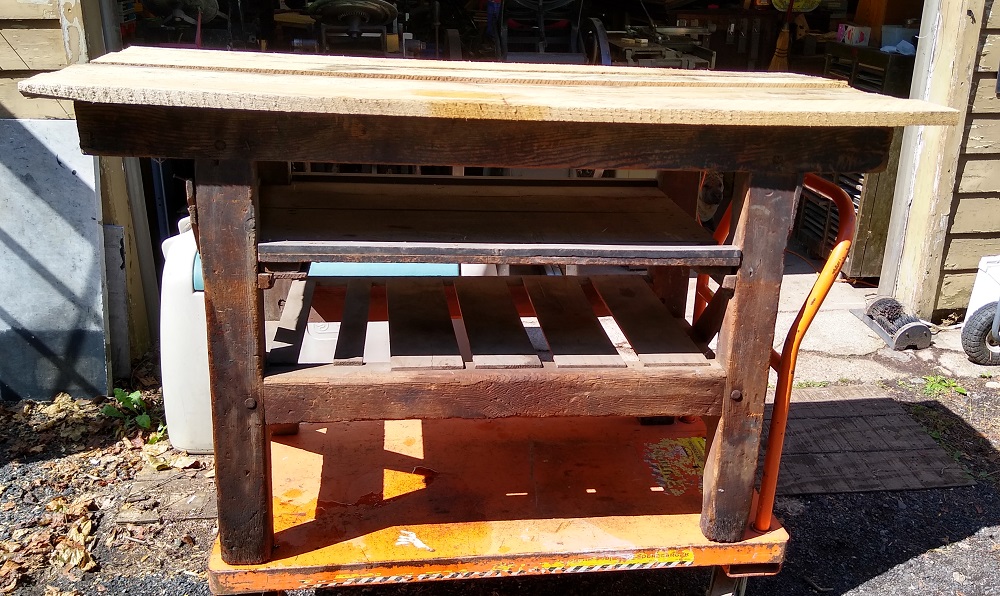 Stone Table Stone Table
Stone
Table 27x63" - 100
pounds
Stone Top
24x36" - 150 pounds*
MDF
Faux
"Stone" 24x36" - 30 pounds
*(alternate)
Furniture
Cabinet 9x12x28h"
(approx.) 25 pounds
This table is known as "The Stone"
due to the heavy 2"x24"x36" smooth
granite slab on top of it.  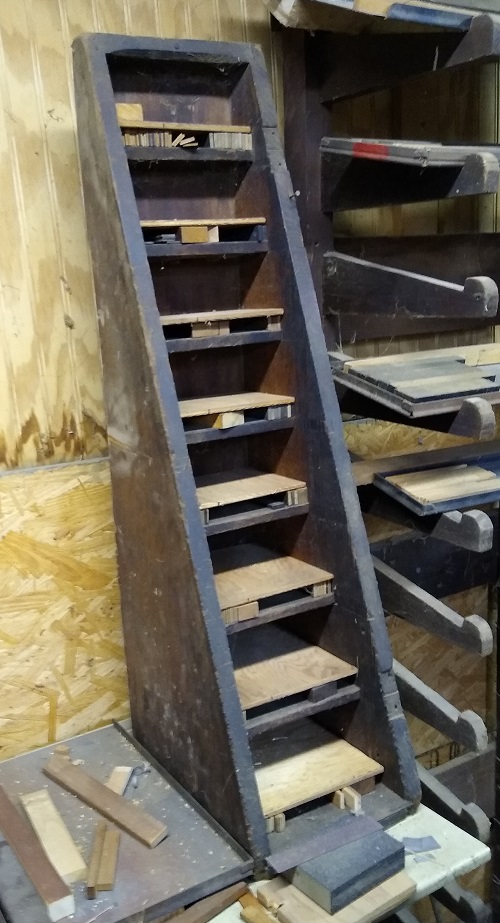 The
Stone is also referred to as the "Makeup
Table" since it is used to make up type
forms for printing and includes a small
wooden "furniture cabinet" filled with
precisely cut wooden spacing material
used by the type setter to space out the
type form as he locks it into the chase
(steel frame) The
Stone is also referred to as the "Makeup
Table" since it is used to make up type
forms for printing and includes a small
wooden "furniture cabinet" filled with
precisely cut wooden spacing material
used by the type setter to space out the
type form as he locks it into the chase
(steel frame)
 The Stone can
also be used as an Ink Table,
since once the form is made up and in
the press, it is no longer needed until
the printing job is done. Meanwhile, it
serves as an excellent smooth surface
for mixing ink and maintaining a supply
for inking the form. The Stone can
also be used as an Ink Table,
since once the form is made up and in
the press, it is no longer needed until
the printing job is done. Meanwhile, it
serves as an excellent smooth surface
for mixing ink and maintaining a supply
for inking the form.
And, due to the weight
of the actual stone, we are also
preparing a "prop" stone made of
laminated MDF, painted to look like
granite. This may be more appropriate
for this application. It will look the
same - but will be much
easier to handle
safely.
Click
on either photo to compare the stones
|
The Proof Press
C&P Proof Press
24x35" 300
lbs (est.)
The Galley Proof Press would
be used to print a proof-reader's sample
of the type that has been set. It can be
used to print short run jobs as well,
but is not as well suited to that task
as it is to print galley proofs of type.
The Hoe Company began making
presses like this one in 1840.
|

|
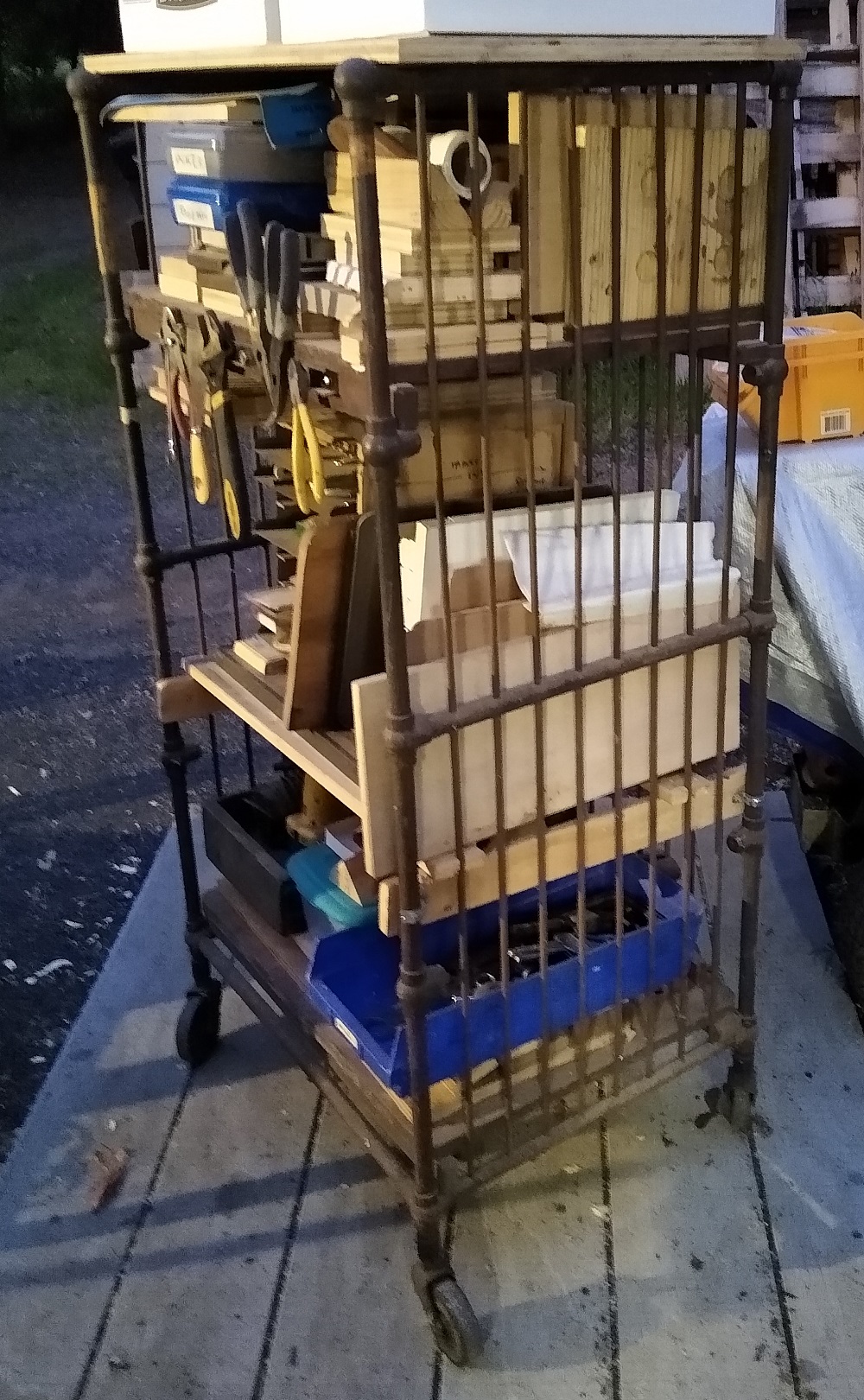 Bindery Cart Bindery Cart
Bindery Cart
21x27" 50
pounds (est)
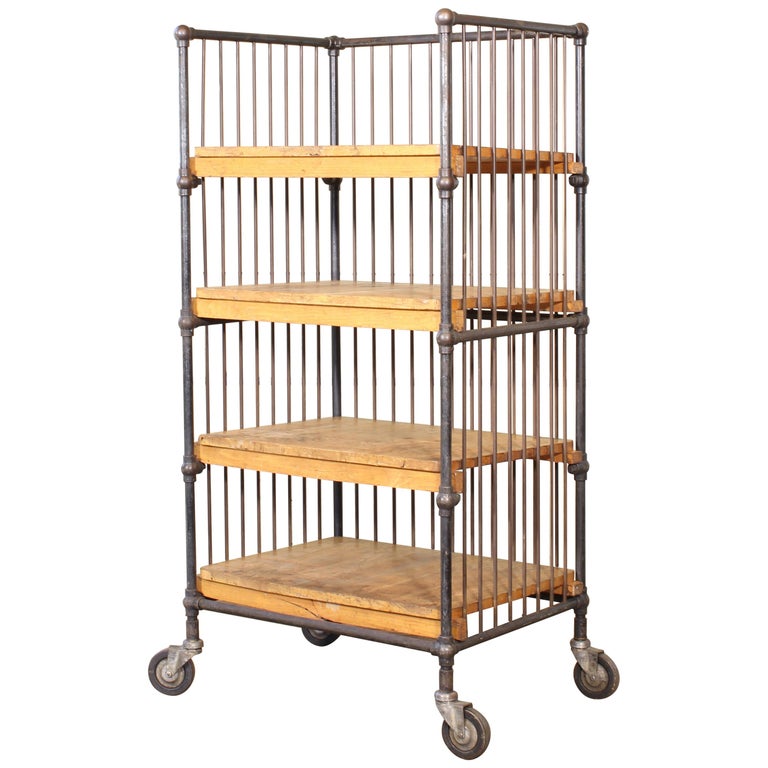 The Bindery
Cart would be used to move
paper around the shop. The shelves are
sloped slightly to the rear to prevent
tall stacks of paper from falling over
while the cart is being moved from the
press room to the bindery. The Bindery
Cart would be used to move
paper around the shop. The shelves are
sloped slightly to the rear to prevent
tall stacks of paper from falling over
while the cart is being moved from the
press room to the bindery. 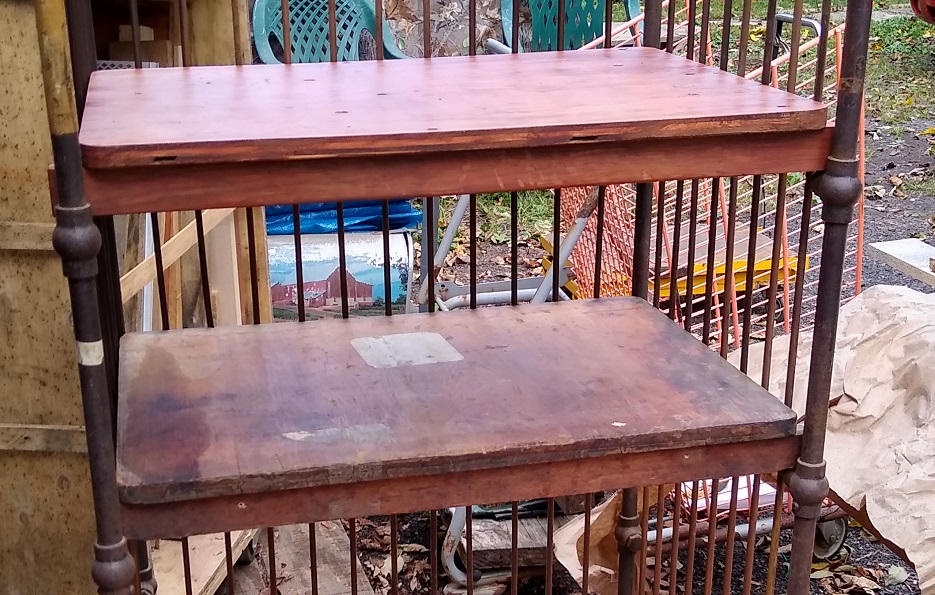
It can also be used to bring blank
sheets to the press for printing. We
made a proper, historically accurate new
shelf for this old cart.
|
Type Case
Stand (aka Type Cabinet)
Type
Cabinet
28x36" - 25
pounds
15 type cases - stacked
25x32x20" high - 150 pounds
The Type Cabinet holds ten -
fifteen drawers of hand-set foundry type
- letters - lots and lots of letters.
The Typesetter picks letters out of the
cases and assembles them into rows and
columns of type for printing.
When filled with cases, two are left on
the top - an "Upper" Case - containing
capital letters and a "Lower" case
containing lower-case letters.
|
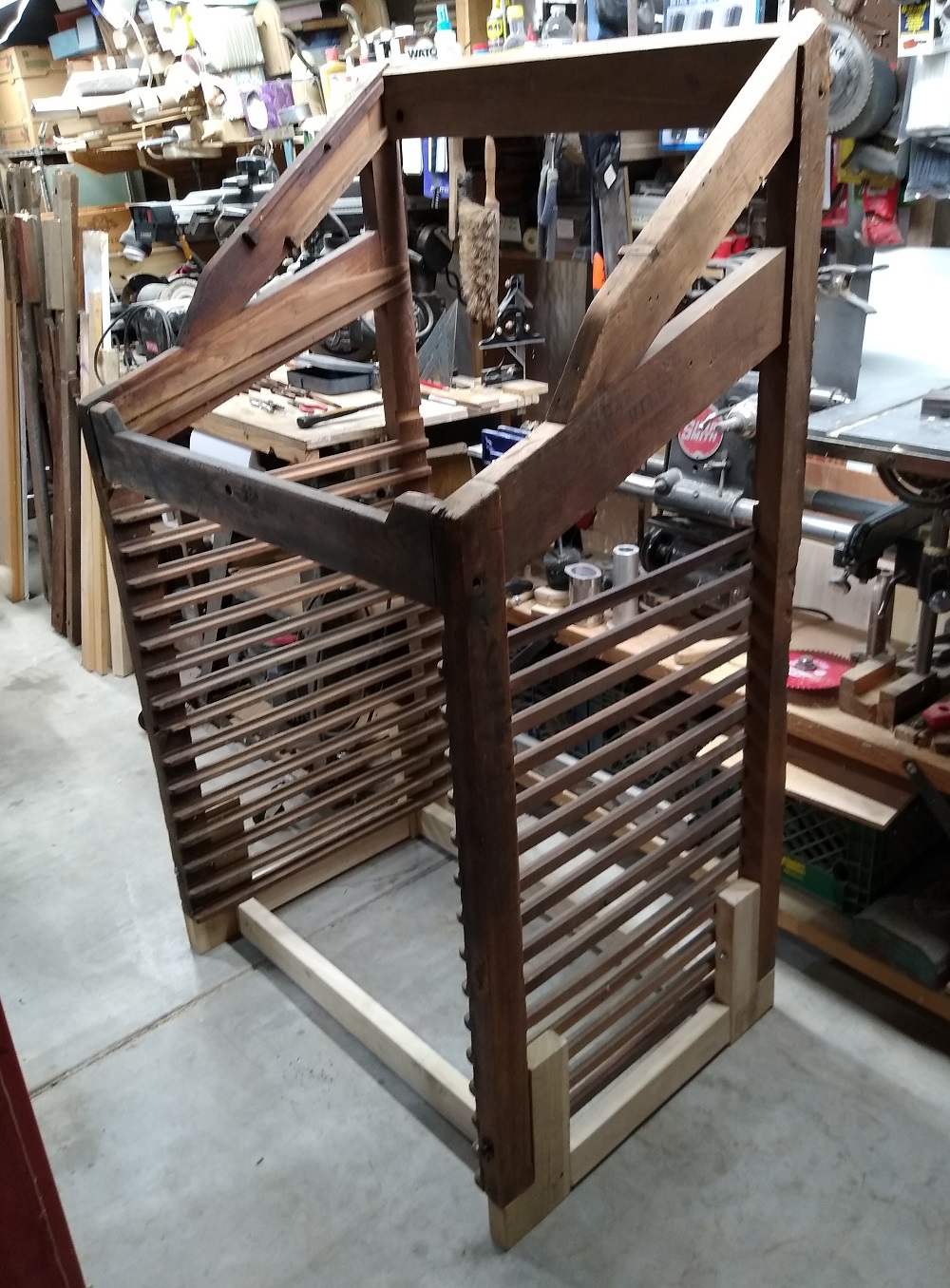 |
Suggested
Layout for Historically Accurate
Representation of a small printing
office circa 1859
In this layout, the TYPESETTER
would move only left and right -
from the type cabinet to the proof
press, then on to the stone to lock up
the form, then back to his type cases
without interfering with the printers.
The
INKER would stand where he is
and move to the left to get ink, then
apply it to the form from where he is.
The PRESSMAN
would stand where he is, crank the bed
in and out and pull the lever, then
crank the bed out and open the frisket -
all without moving much at all. The FEEDER would
take blank sheets from the Bindery Cart
(or a table), and insert them into the
tympan. The pressman would close the
frisket, crank the bed under the platen
and continue... One printer could do
50-100 pieces per hour. With three
printers, output could be more than
doubled.
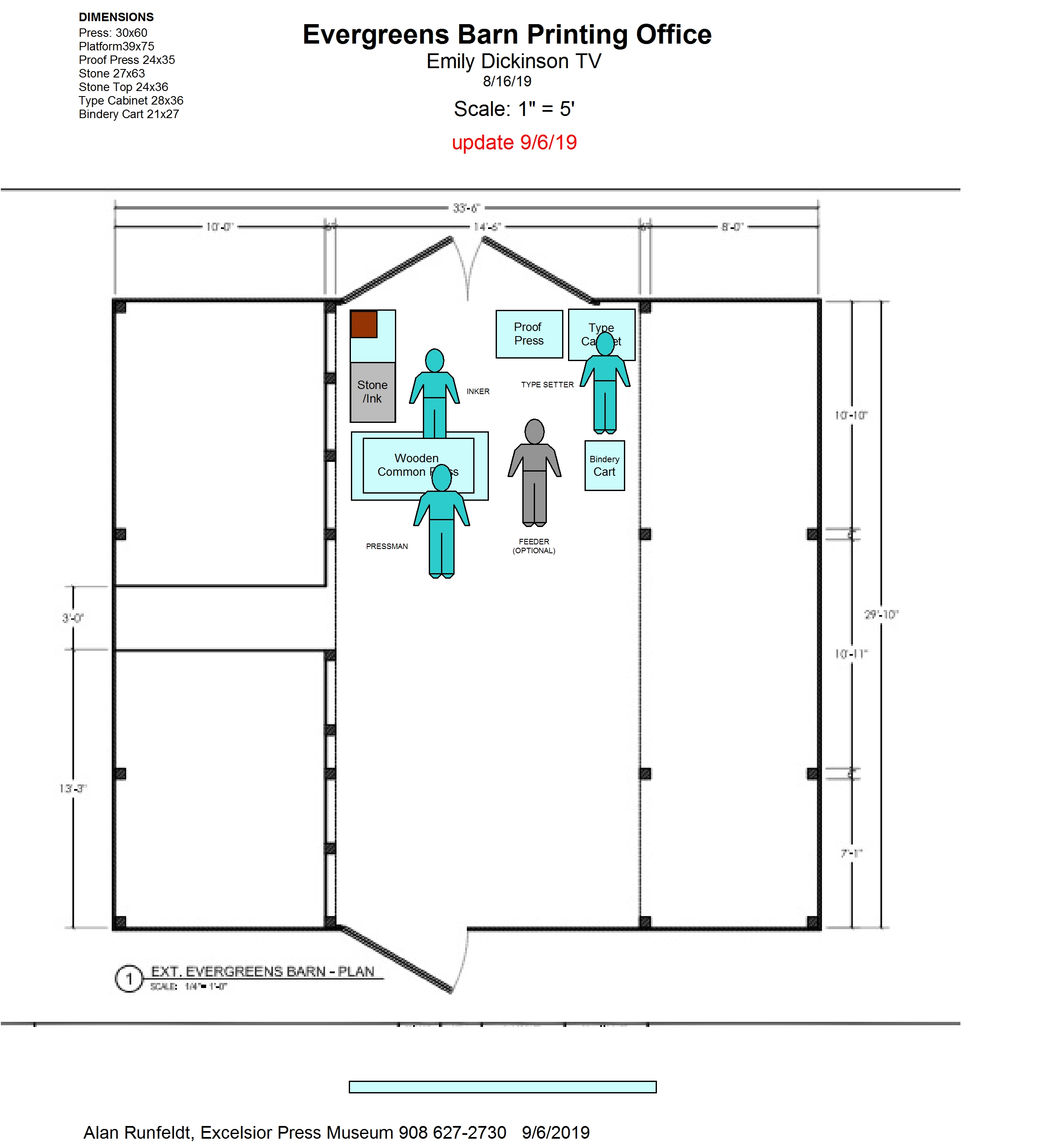
|
Complete List
of Items:
- 1 Full Scale, Wooden
Common Press (similar to one
that would have been made by
Adam Ramage in 1840) - with
chase
- 1 Stone Makeup Table
with with 24x36x2"
granite stone surface
- 1 Furniture Cabinet (shelves)
with wood spacing material
- 1 Galley
Proof Press on Stand ("made by" Hoe
circa 1840)
- 1 Bindery Cart
- 1 Type Cabinet
- 2 type cases
with type
- 10
type cases - empty
- 1 Old-style
Composing Stick
- miscellaneous
"stack" of wood-mounted metal
engravings
- 1 large ink brayer
(ink roller)
- 1 container of black
ink (Van Son Rubber Base 10850 -
old style can; no label)
- 1 ink knife
- 5 sheets press
tympan paper
- 5 sheets soft
packing
- 50 sheets 17x22 bond
- 50 sheets 11x17 70#
offset
- 2 printers' shop
aprons
- selection of wooden
quoins & wooden shooting
stick
- 1 wood mallet
- 1 leveling planing
block
- Hemp Cord for paper
drying line.
- ...tbd...
|
|
|
~~~~~~~~~~~~~~~~~~~~~~~~~~~~~~~~~~~~~~~~~~~~
page
last updated September 6, 2019
|